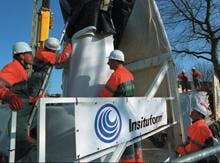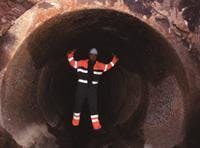Insituform crew members use hydrostatic pressure to invert the massive tube into the sewer.
Click here to enlarge imageTilburg city officials first became concerned about the concrete pipe when they noticed several gaps in the road above it. Further inspection found several leaking joints, which were made worse by rising groundwater.
The city opted for the Insituform® cured-in-place pipe (CIPP) rehabilitation method after considering several alternatives. On a typical CIPP project, a crew works from a manhole, using water pressure to insert a flexible liner inside the sewers. Once in place, the liner is then heated and cured into a structurally sound pipe-within-a-pipe with a life span comparable to that of a new sewer. Given the Tilburg sewer size, however, this project wasn't exactly typical.
The liner's thickness was first calculated to withstand the area's groundwater pressure and then a custom-made felt tube was ordered from Insituform® Linings PLC, the UK manufacturer of Insituform materials. Normally, the felt tube would then be shipped to the company facility in Delft, The Netherlands, to be impregnated with thermosetting resin. Instead it was shipped to Insituform France because of the tube's large size. The French facility has the facilities needed for the special large-diameter vacuum impregnation process. There, over the course of three days, workers injected more than 70 tons of thermosetting resin into the 289-meter-long tube.
The "super-sized" impregnated tube required special transportation to make the trip to Tilburg. The resin-filled tube, plus the trailer produced a combined total load of approximately 100,000 Kg. Alternate routes added an additional 300 km to the trip because of load restrictions on some roadways.
On 10 February workers closed incoming sewers and dismantled a manhole in the vicinity of the sewer line. The dismantling was necessary because the impregnated tube couldn't fit through the existing 20 1/2-inch-diameter manhole. By the time the tube arrived at the site at the end of February, Insituform and Tilburg officials had already made preparations for handling traffic and ensuring the safety of the workers and passersby.
On 21 February workers used hydrostatic pressure to invert (turn inside out) the massive tube in the sewer through the dismantled manhole. The water pressure forced the tube through the pipe while pressing it tightly against the inside of the existing pipe. Once the tube reached the termination point, the inversion water - all 950 m3 of it — was circulated through four heat exchangers to reach a temperature of approximately 80ºC. The heat cured the resin, forming the tube into a hard, joint-less and corrosion-resistant pipe-within-a pipe. After the water cooled down and was removed, workers opened and then renovated the 19 lateral sewers connected to the main line.
Tilburg city employees walked through the renovated sewer to see the results for themselves, before reopening the sewer on 28 February 2003.
Author's note
Edwin Uppelschoten is the account manager at Insituform Rioolrenovatietechnieken bv, based in Delft, The Netherlands. Insituform Technologies, Inc. specialises in the use of trenchless technologies to rehabilitate, replace, maintain and install underground pipes. Additional information about the company can be obtained at www.insituform.com 



